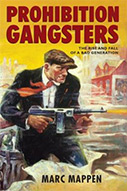Prohibition Gangsters: The Rise and Fall of a Bad Generation

Author: Marc Mappen
Publisher: New Brunswick, NJ: Rutgers University Press, 2013. 256p.
Reviewer: Jay Albanese | March 2014
Written for a general audience, Prohibition Gangsters offers a popular historical overview of the criminal careers of gangsters from the Prohibition era. The book discusses approximately 60 individuals, born in the late 1800s or very early 1900s, whose notoriety is tied closely to the 18th Amendment, as most of them had some degree of success in the illegal manufacture and distribution of alcoholic beverages.
Nearly all of those included are Italians or Jews who came to America as children or were born into new immigrant families. Most were in their twenties at the time Prohibition was enacted (in 1920), so their rising criminal careers corresponded with this large, new criminal opportunity of banned alcoholic beverages coexisting with a continuing and overwhelming public demand for those same beverages. Prohibition did more to create and strengthen organized crime operations in the U.S. than any other single event. It was a dramatic case of the unintended, but foreseeable, consequences of the prohibition of a product in very high public demand.
The book is organized into 12 chapters, centered around events that characterize the era from the early to the late 20th century. All but one of the gangsters described in the book was dead by the end of the century (the exception Joe Bonanno died at age 97 in 2002).
The author of the book is a historian, and the information in the book is taken largely from biographies of notorious gangsters, media accounts from the early 20th century, and books written about organized crime during the period. One of the best features of this book is its attempt to reconcile different accounts of major mob meetings, murders, and disappearances. It spares the reader from having to make sense of widely different accounts of the same events in various books. In general, the book finds that the larger-than-life accounts of major mob murders and meetings generally oversold or fictionalized what actually occurred.
Mappen devotes extra space to the Capone-era Chicago, and to organized crime in New York/New Jersey. There is also some coverage of organized crime during this era in Detroit (Purple Gang), Kansas City (Tom Pendergast), and Cleveland (Moe Dalitz and Joe Lonardo). Significant attention is also devoted to recounting major events in organized crime history from the 1920s into the 1950s. This period includes significant murders, arrests, trials, and meetings.
This book is not a criminological effort. It does not cite much of the work about organized crime in the social science literature, although it hits on a few important works and themes from this period in the history of organized crime. For example, only a few pages are devoted to each gangster (due to the more than 60 mentioned in the book), although significant space is devoted to Capone, Luciano, Costello, Buchalter, Siegel, Lepke, and Lansky.
A few interesting conclusions from this book result from this assessment of the overlapping criminal careers of the gangsters of that era:
1. These gangsters "never managed to create an all-powerful, national syndicate that was imagined by their opponents," (p. 6, 159) yet Prohibition forced gangsters to become more organized in handling their supply, demand, the threat of enforcement, and dealing with competitors. In describing Luciano’s mob in the 1920s, which included bootlegging, drugs, and brothels, there may have been as many as 200 men, but "it should be emphasized that the structure was very loose. Anybody searching for an organizational chart with lines of authority would be disappointed" (p. 49).
2. Extortion rackets were the staple of gang activity prior to Prohibition, based on the premise "if you don’t give me money, then something bad will happen to you" (p. 51). Protection is necessarily a locally-based racket because the extortionist must have an established local reputation as a bad actor — one which is known to the victim and neighborhood in order to coerce a payment.
3. The inter-ethnic nature of organized crime described here contradicts the public perception. In many instances there were documented instances of partners and agreements among gangsters who were Italian, Jewish, and Irish.
4. The Atlantic City meeting of gangsters in 1929 is the focus of Chapter 4, and it evaluates past claims of a meeting of the mob, concluding from historical sources (especially Critchley) that this was not a large gathering of mobsters from different cities as the popular literature often claims. As Mappen concludes, "In the end, the only certainty is that a gathering of mobsters occurred in Atlantic City in May 1929. But who they were and what they accomplished is in question" (p. 95).
5. The so-called Castellamarese War during 1930 and 1931 likely never occurred. There was a struggle among Luciano, Masseria, and Maranzano for leadership of the New York rackets, and although many writers have claimed 60 deaths in a "purge" during this period, only a few deaths can be confirmed. Although the "five families" of the New York City mafia were established during this period, the evidence of a ‘war’ is not apparent from the historical record.
More attention to the Apalachin meeting in upstate New York in 1957 would have offered some insight into how reputation and innuendo overtook fact-finding until the investigations of the 1970s. Also, there is no discussion of the continuing public fascination with the "mafia" after the Kefauver Hearings in 1950, despite the nature of organized crime described in this book.
When reviewing the lives and criminal careers of these 20th century gangsters ,a few observations become apparent from the author’s presentation:
- Most suffered from their notoriety, rather than thrived in it like celebrities. Many were prosecuted and threatened by prosecution for much of their adult lives.
- Their notoriety served as a target, and the prosecution of organized crime figures helped build the popularity and political careers of people such as Herbert Hoover and Thomas Dewey.
- Most of the major prosecutions of these gangsters involved failure to pay income taxes, rather than committing organized crime.
- There were few happy endings. Most of these gangsters spent many years in prison, many died there, and others were killed by other gangsters, exiled, or executed by the state. Chapter 10 is devoted to describing some of the more notorious murders (Schultz, Diamond, Lazia, Siegel, Anastasia). Only a few gangsters died naturally outside prison (covered in Chapter 12), and most of these were under a cloud of suspicion until the very end. For example, the Kefauver Senate Committee report that Lucky Luciano was "the czar of a vast and secret underworld government" is characterized by the author as "simply wrong. By the early 1950s Luciano was an aging man with little power, authority, or wealth" (p. 170).
The book includes a helpful listing of the "cast of characters" at the end, together with very brief summaries of their lives. This helps readers not familiar with particular individuals to keep track of who was who.
In sum, this book is an interesting effort to review a generation of gangsters, whose efforts to profit from crime were successful for short periods, but were usually interrupted by violence from competitors, prosecution by the government, or untimely death.
Jay S. Albanese, Professor, Virginia Commonwealth University, Wilder School of Government & Public Affairs.


